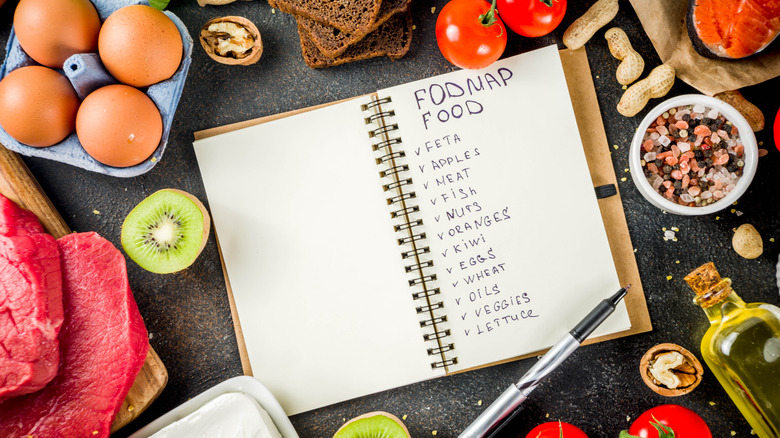What You Should Know Before You Start The Low FODMAP Diet
In a world that frequently makes people feel like their self-worth is linked to their health and their value as a person comes down to what they look like, it's no wonder that, as a global society, we're unhealthily obsessed with dieting and nutrition. The low FODMAP diet is just one in a long list of eating plans that has attracted global interest. But unlike other diets, the low FODMAP diet has specifically been designed to help people with diagnosed irritable bowel syndrome (IBS) or small intestinal bacterial overgrowth (SIBO). According to Johns Hopkins Medicine, the diet eliminates foods that may cause intestinal stress, helping those with the mentioned conditions to identify what foods cause symptoms and then permanently cut them out.
FODMAP stands for fermentable oligosaccharides, disaccharides, monosaccharides, and polyols. These are short-chain carbohydrates that can be harmful to some as the small intestine tends to struggle to absorb them. While the low FODMAP diet can help people with certain medical issues to eliminate problematic foods, it isn't for everyone. For those with symptoms of IBS or SIBO who are thinking of trying this diet, there are a few important things to consider first.
What does the low FODMAP diet involve?
The first thing to know about the low FODMAP diet is that it's incredibly restrictive. It cuts out large numbers of foods from a wide range of food groups. Among those that are considered high FODMAP are whole grains such as wheat and rye; dairy products such as milk, yogurt, and soft cheese; some nuts and legumes; fruits such as watermelon and mango; and vegetables like cauliflower and mushrooms (via Healthline). Garlic and onions have also been identified as being high in FODMAPs. These foods can worsen the symptoms of digestive conditions like IBS, which usually present as abdominal pain, bloating, and changes in bowel movements (via the Mayo Clinic).
Monash University, the institution whose research team originally developed the diet, explains that the whole process consists of three steps. The low FODMAP diet, where participants cut out high FODMAP foods, lasts only between two and six weeks. During this time, they eat low FODMAP foods only, such as beef, chicken, rice, lentils, bell peppers, spinach, and certain nuts and cheeses. If a person's symptoms improve, they reintroduce one FODMAP food at a time over a period of eight to 12 weeks, which may help pinpoint which foods are the most problematic for them. The third step involves participants creating their own long-term eating plan based on the findings of the first two steps.
Therefore, the actual low FODMAP diet itself is a short-term eating plan only and should not be followed for longer than six weeks. Even then, it isn't for everyone.
Potential problems with the low FODMAP diet
The low FODMAP diet can help those with digestive conditions to discover what foods to avoid. But for others, the diet can actually do more harm than good by depriving participants of nutrients. According to Harvard Medical School, the low FODMAP diet especially deprives those who are already on restricted diets. The institution outlines that restricting high FODMAP foods over a long period of time also "changes the makeup of bacterial colonies in the gut, which may negatively impact intestinal health and possibly worsen digestive issues over time."
Because the low FODMAP diet is so restrictive, it's not recommended for anyone with disordered eating habits, as the strict nature of the diet can trigger or worsen these habits (via Gastroenterology Adviser). Even in those without a history of disordered eating, restrictive diets like the low FODMAP can kick off a cycle of binge-eating behavior which may eventually lead to a binge-eating disorder. Unlike overeating, Health Partners points out, binge eating involves recurring, persistent episodes where a person eats rapidly past the feeling of fullness, even if they're not hungry. Binge eating is usually done alone because a person may feel embarrassed by how much food they're eating, and then feels distressed and ashamed because of the episode.
Ultimately, the more restrictive a diet is, the more likely a person is to eventually binge eat. The bottom line is that while a low FODMAP diet can help people with certain stomach conditions, it is not appropriate for everyone and should only be followed temporarily.


